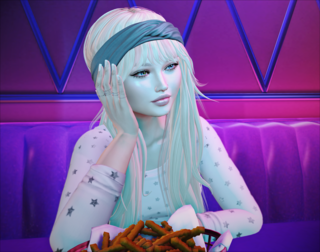
Second Life is an online multimedia platform that allows people to create an avatar for themselves and then interact with other users and user created content within a multi player online virtual world. Developed and owned by the San Francisco-based firm Linden Lab and launched on June 23, 2003, it saw rapid growth for some years and in 2013 it had approximately one million regular users. Growth eventually stabilized, and by the end of 2017 the active user count had declined to "between 800,000 and 900,000". In many ways, Second Life is similar to massively multiplayer online role-playing games; nevertheless, Linden Lab is emphatic that their creation is not a game: "There is no manufactured conflict, no set objective".

A virtual world is a computer-simulated environment which may be populated by many users who can create a personal avatar, and simultaneously and independently explore the virtual world, participate in its activities and communicate with others. These avatars can be textual, graphical representations, or live video avatars with auditory and touch sensations. Virtual worlds are closely related to mirror worlds.

In computing, an avatar is a graphical representation of a user or the user's character or persona. Avatars can be two-dimensional icons in Internet forums and other online communities, where they are also known as profile pictures, userpics, or formerly picons. Alternatively, an avatar can take the form of a three-dimensional model, as used in online worlds and video games.

In science fiction, the "metaverse" is a hypothetical iteration of the Internet as a single, universal, and immersive virtual world that is facilitated by the use of virtual reality (VR) and augmented reality (AR) headsets. In colloquial usage, a "metaverse" is a network of 3D virtual worlds focused on social and economic connection.
In the virtual world of Second Life, there are a number of in-world business and user-groups founded specifically for the game, some of which have become legal entities in their own right, as well as preexisting companies and organizations that have involved themselves in the world.
Cyberformance refers to live theatrical performances in which remote participants are enabled to work together in real time through the medium of the internet, employing technologies such as chat applications or purpose-built, multiuser, real-time collaborative software. Cyberformance is also known as online performance, networked performance, telematic performance, and digital theatre; there is as yet no consensus on which term should be preferred, but cyberformance has the advantage of compactness. For example, it is commonly employed by users of the UpStage platform to designate a special type of Performance art activity taking place in a cyber-artistic environment.
The Metaverse Shakespeare Company, produces Shakespearean and other plays in the Second Life virtual world. Professional and amateur talent is used for productions in a replica of the Globe Theater. The actors are special purpose avatars, controlled by prerecorded and real time live input. The initial program audiences are residents of Second Life, however performances are available outside Second Life. The first abbreviated performance was of a scene from Hamlet in February 2008 under the guidance of Ina Centaur, the company’s Visual Director. The company is funded by donations.

Twinity is a 3D online virtual world. Initially developed by Metaversum GmbH, it is currently held by ExitReality. The game offers its population, called Twinizens, to navigate around virtual (historical) versions of real-world cities, also called a mirror world or a Metaverse. A public beta began in September 2008 with the release of the first virtual city, Berlin, which later was followed by Singapore, London, Miami and New York. Twinity is built on BigWorld Technology and its economy is based on a free-to-play model.
Virtual worlds are playing an increasingly important role in education, especially in language learning. By March 2007 it was estimated that over 200 universities or academic institutions were involved in Second Life. Joe Miller, Linden Lab Vice President of Platform and Technology Development, claimed in 2009 that "Language learning is the most common education-based activity in Second Life". Many mainstream language institutes and private language schools are now using 3D virtual environments to support language learning.
Arts in Second Life is an artistic area of a 3D social network that has served, since 2003, as a platform for various artistic pursuits and exhibitions.
Annabeth Robinson, whose online Second Life alias is AngryBeth Shortbread, is a multi-media artist and lecturer based in Leeds, UK where she focusses on the teaching of audio, visual and online technologies. Using Second Life and other Multi User Virtual Environments (MUVEs), Robinson explores their potential as a medium for art and design practice whilst examining its educational potential. Robinson has been undertaking such projects since 2005.
Avatar Repertory Theater commonly known as ART, is a theatre troupe that performs primarily in the virtual world Second Life, though they have recently extended to other virtual platforms such as OSGrid and Kitely.
The Avatar Orchestra Metaverse (AOM) is a large collaborative group of performers spread across three continents, who incorporate the use of online avatars alongside virtual instruments, to create a variety of audio-visual performances within Second Life.

A virtual concert, also called V-concert or virtual live, refers to a performance in which the performers are represented by virtual avatars. Virtual concerts can take place in real life, where digital representations of the performers are projected in on stage, or within fully digital virtual worlds. Real life concerts are popular in South Korea, where performances by groups such as Girls' Generation have attracted thousands of fans. Performers in virtual concerts may represent real individuals, but can also be entirely fictitious characters like Hatsune Miku.

Ballet Pixelle is a ballet company founded in 2006 by choreographer Inarra Saarinen. Saarinen still serves as artistic director and choreographer. Ballet Pixelle is the first dance company to perform completely in virtual reality. Its goal is to explore and extend physical and virtual dance and movement and to blend those realities.
Sansar is a social virtual reality platform, for Microsoft Windows only, developed by the San Francisco-based firm Linden Lab, and now owned by Sansar Inc. It launched in “creator beta” to the general public on July 31, 2017. The platform enables user-created 3D spaces where people can create and share interactive social experiences, such as playing games, watching videos, and having conversations in VR. Each participant is represented by a detailed avatar that is the graphical representation of the user including speech-driven facial animations and motion-driven body animations.

VRChat is an online virtual world platform created by Graham Gaylor and Jesse Joudrey and operated by VRChat, Inc. The platform allows users to interact with others with user-created 3D avatars and worlds. VRChat is designed primarily for use with virtual reality headsets, such as the Oculus Rift and Oculus Quest series, SteamVR headsets, and Windows Mixed Reality, but is also usable without VR in a "desktop" mode designed for either a mouse and keyboard or gamepad.
Sinespace is a free-to-play massively multiplayer online Unity 3D-based platform created and published by Sine Wave Entertainment. It enables users to create and sell 3D content and interact with others as 3D avatars. It was beta launched in November 2016 and teamed up with Unity to make its SDK available in the Unity Asset Store in March 2019. It supports Oculus Rift, HTC Vive and Windows Mixed Reality headsets, but is also accessible through PC, Mac, Linux, and Chrome web browsers.

NeosVR is a free-to-play, massively multiplayer online, virtual reality application created by Solirax. It was released for free on Microsoft Windows via Steam on May 4, 2018, with support for several VR headsets.

Horizon Worlds is a free virtual reality, online video game with an integrated game creation system developed and published by Meta Platforms. On this multi-player virtual platform, players move and interact with each other in various worlds that host events, games, and social activities. The game works on Oculus Rift S and Meta Quest 2 headsets.


















